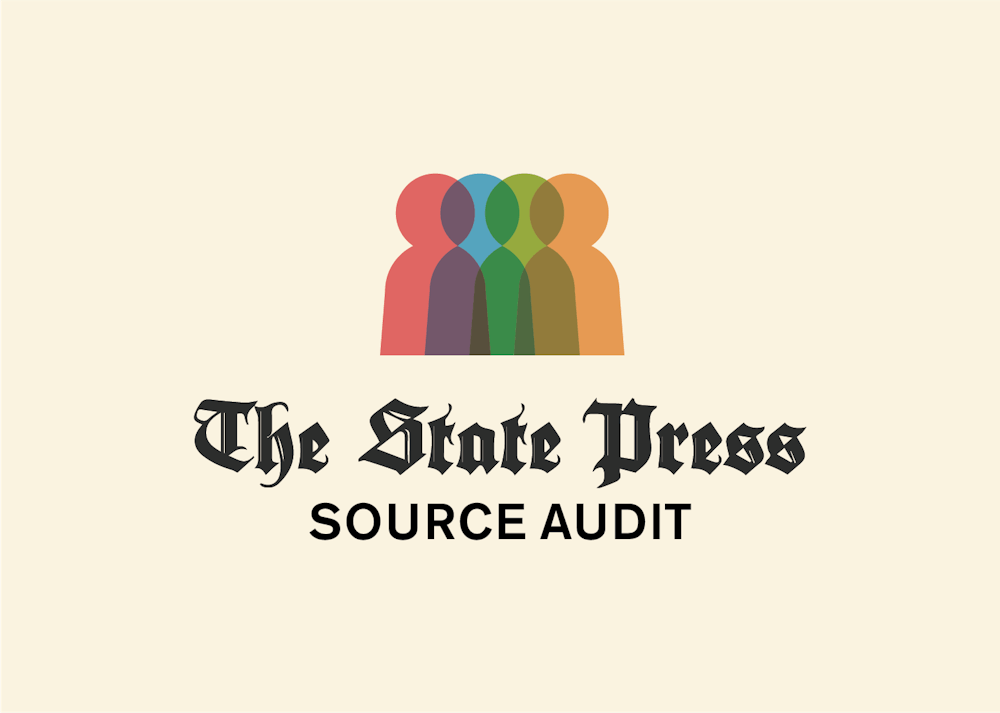The State Press began tracking its sources in Fall 2020 to better understand the demographics of the people featured in published content.
Since then, The State Press has published a semesterly report on these demographics to provide transparency for readers regarding the stories we cover and the sources we talk to. Understanding this data is critical for the newsroom to ensure coverage is representative of our community, and to begin making the correct steps if not.
We instruct our reporters to ask each person they interview, including sources whom a reporter has personally reached out to and spoken with (not including press releases, press conferences, public meetings or other large-scale events) a series of questions.
Each source is asked about their race, religion, gender, pronouns, age and occupation. Sources may decline to answer some or all of the questions, and all responses are reported anonymously.
To ensure the highest possible accuracy in our data collection, student members of The State Press verify the number of people quoted in each story published online with the number of source audit responses collected internally.
In Spring 2022, we collected a total of 513 source audit reports across digital, magazine and multimedia departments.
The percentages for each of the graphs shown below are rounded, so the graphs may not add up to 100%.
Race and ethnicity
Out of the 477 sources who shared information about their race and/or ethnicity, 65.7% were white. This was an increase from 53.71% in Fall 2021.
The second most represented group was sources who identify as Latine or Hispanic, making up 12.11% of the sources. This was an increase from 11.13% in Fall 2021.
People who identify as Asian made up 9.19% of our sources, slightly lower than our Fall 2021 results of 10.35%.
People who identify as Black or African American made up 7.17% of our sources in Spring 2022, a decrease from 8.79% in Fall 2021.
People who identify as Middle Eastern or North African made up 3.14% of our sources, an increase from 2.54% in Fall 2021. People who identify as Indigenous or Native American made up 2.02% of our sources in Spring 2022, consistent with 2.34% in Fall 2021.
People who identify as Pacific Islander made up .45% of our sources in the spring and .98% in the previous fall.
Of the 477 sources who shared information about their race and ethnicity, 31 identified as more than one race and/or ethnicity. Those sources were included in the counts for the races and ethnicities they identified as.
Religion
Of the 513 sources in the Spring 2022 source audit results, 265 people did not share a response to the question about religion. Of the people who did, the largest group was agnostic, making up 18.15% of responses.
The second and third largest groups were non-Catholic Christian sources and Catholic sources, making up 17.34% each. Atheist sources were 15.73% of respondents. Jewish sources were 10.89% of responses. Sources who identified as spiritual made up 6.85% of responses. Muslim sources made up 6.45% of
sources. Sources who were not affiliated with any religion made up 4.03% of sources.
Gender
Male and female sources made up similar percentages of sources at 48.37% and 49.18% respectively. This is similar to the fall semester's results when female sources made up 46.1% of the respondents, and male sources were 45.9%.
Nonbinary and genderqueer people made up 2.44% of sources, which is a decrease from 4.7% in the previous semester.
Pronouns
Sources who identified with he/him pronouns made up 46.50% of respondents. Sources who identified with she/her pronouns made up 49.21% of respondents. Sources who use they/them pronouns made up 1.58% of respondents. Sources who use she/they and they/she pronouns made up 2.26% of respondents. Sources who use he/they pronouns made up 0.23% of respondents.
Age
The spring semester's results show an increase among the 18- to 23-year-old population at 55.99% compared with 49.22% in the Fall 2021 semester.
Our second most sourced age group was 41-50 years old, with 12.85% of our respondents saying they were in that group, compared with 11.13% from the previous semester.
Those who said their ages were between the 51-60 year category decreased from 8.2% to 5.88% in the spring semester.
Occupation
To improve our understanding of the jobs or industries of the people we sourced, we included a question about occupation in the Spring 2022 source audit.
The options included student, University faculty, staff or administration, government official, health care, legal professions, law enforcement, media/public relations, arts, sports, business and other professions.
University faculty is defined as tenured, assistant, and postdoctorate scholars whereas University staff is someone who works at the University, but does not teach. Deans, chief officers and anyone in University leadership positions are considered to be University administration.
Students were the largest group sourced, representing 45.8% of the sources reported. This is a decrease from 49.02% in the fall semester.
People in the sports industry, which includes coaches and athletes, made up 17.4% of sources.
University faculty and administration made up 12.8% and 5.4% of sources, respectively.
Final thoughts
In all of our work, we constantly assess which communities we need to better source, represent and understand in order to best serve the ASU community. Our outreach extends beyond ASU, and there are no perfectly comparable data sets that represent our scope.
There are some areas in which we fell short in our Spring 2022 sourcing:
While the percentage of Hispanic and Latine sources in Spring 2022 increased from Fall 2021, it is still far lower than the percentage of Hispanic and Latine students at ASU. In data reported by ASU, in Fall 2021, 22.3% of students were Hispanic or Latine. The U.S. Census Bureau estimated 32% of Arizona's population was Hispanic or Latine in 2021. In Spring 2022, just 12.11% of our sources were Hispanic or Latine.
In Spring 2022, 65.7% of our sources reported in the source audit were white. This was an increase from the previous semester and is far higher than Arizona's Census 2021 report of 53.2% white residents.
Moving forward, we will continue to emphasize to newsroom staff of all levels the importance of completing the source audit, reflecting on its results, and making and executing plans for how to improve our sourcing in the future.
In Spring 2023, The State Press is redesigning our outreach model to meet members of the ASU community where they are and take a more active role in the community we serve. This is in hopes of building trust with the communities we cover as well as building stronger lines of communication between our newsroom and community members.
Efforts in this new approach will include tabling around campus, continuing to engage with community and campus groups in a non-reporting capacity, and increasing training opportunities in the newsroom. We will integrate more frequent analyses of our sourcing throughout the semester so we have a more active response to the places we need to improve in our sourcing. This will involve staff at all levels and departments in our newsroom.
We continue to invite members of the ASU community to share their thoughts and feedback with The State Press, and to tell us about what's important to you and what you want to know more about. To get in touch, email diversity.statepress@gmail.com and/or execed.statepress@gmail.com.
Edited by Greta Forslund, Piper Hansen and Kristen Apolline Castillo.
Reach the diversity officer for the Spring 2022 semester at anatar12@asu.edu or follow @AnushaNat1 on Twitter. Reach the diversity officer for the Fall 2022 semester at sbalas44@asu.edu and follow @sophiabala1101 on Twitter.
Like The State Press on Facebook and follow @statepress on Twitter.


Sophia Balasubramanian currently serves as the Diversity Officer for the State Press. She previously worked on the Echo as an editor and reporter.




